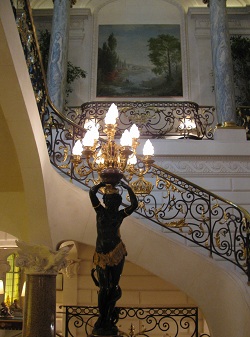
Considerations on the location, the decor and the Eiffel Tower views of the Shangri-La Hotel in Paris, a 5-star hotel in the 16th arrondissement, including tea in the lounge, a drink at the bar and dinner in one of its three restaurants.
Location
The choice of a long-ignored block of Paris’s 16th arrondissement for the Shangri-La Hotel was considered questionable well before the 5-star establishment opened in December 2010. Respectably askew from the glitter of the city’s Golden Triangle, this part of Avenue Iéna is considered by some to be a kind of no-man’s land bordered by lesser known museums. But it is indeed a worthy location.
True, there are no LVMH storefronts across the street— instead, there’s the breathtaking permanent collection of Asian art at the Guimet Museum nearby. And there are no colorful Paris macaroons in bakery shop windows in the neighborhood—instead, on Wednesday and Saturday mornings one of the capital’s most appealing outdoor produce and flower market unfurls around the corner on Avenue du Président Wilson.
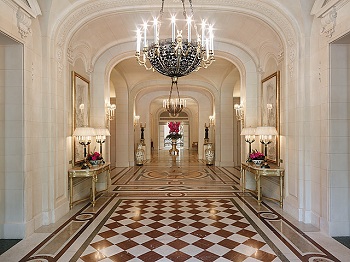 I would understand better if people argued that it was difficult to get a taxi in the immediate area on a rainy day. I imagine it is. Then again, taxis are hard to come by in any neighborhood in Paris on a rainy day.
I would understand better if people argued that it was difficult to get a taxi in the immediate area on a rainy day. I imagine it is. Then again, taxis are hard to come by in any neighborhood in Paris on a rainy day.
The Shangri-La may not be central to the Golden Triangle, but a great hotel is capable of being the center of its own universe. This hotel is still developing and at this writing has yet to prove such greatness, at least not to me, but it does have a quiet grandness. Besides, the location of choice in the City of Light isn’t a street or an arrondissement but Paris itself.
Anyway, the location is Paris enough that I heard a generous amount of well-spoken French in the tea room/lounge while having a cup of Pu’er chrysanthemum tea. I’ve no special affection for flowery teas, but while waiting for an appointment in the hotel lounge with a cup and a pot of it in front of me, I realized that it didn’t matter how central the hotel was because I was the one who was centered.
Décor
The building at the heart of the Shangri-La, the former Palais Iéna, was built 1892-1896 as the home of Roland Bonaparte (1858-1924), Napoleon Bonaparte’s grandnephew.
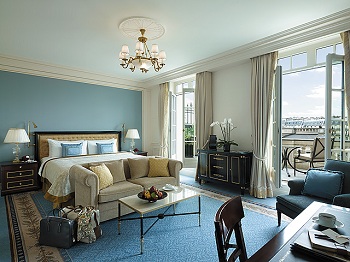 Shangri-La is an Asian chain (this is their first European venture) yet it has largely maintained the original patrician Parisian spirit of the ground-floor public rooms. They were and remain an ode to the marriage of aristocracy and industrial achievement. The hotel’s public spaces successfully play the Parisian parlor game of showing class through restraint.
Shangri-La is an Asian chain (this is their first European venture) yet it has largely maintained the original patrician Parisian spirit of the ground-floor public rooms. They were and remain an ode to the marriage of aristocracy and industrial achievement. The hotel’s public spaces successfully play the Parisian parlor game of showing class through restraint.
Shangri-La has not set out here to offer Parisians an Asian touch but to offer a Parisian home to travelers who may well have already been to Asia. Nevertheless, the welcome tea in the rooms, the Ming-inspired vases by the entrance, the veneers, the occasional silk vest (an awkward touch, sorry to say, on otherwise Paris service folk) and some coy feminine nods let us know that the Shangri-La chain is indeed based in Hong Kong.
There’s a stolid luxury here of revisited early 19th-century themes of straight lines, dark wood, marble, bronze, gilt. The beautiful wallpaper and wall fabrics made me want to caress the walls in the corridors and in the bedrooms. The high-class amenities and gadgetry (e.g. TV integrated into the mirror) are all present as in any recent hotel of this standing.
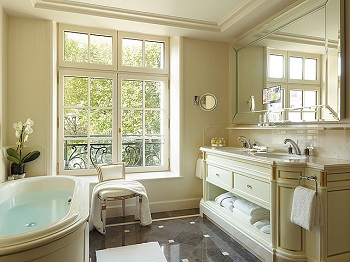
The décor edges towards clarity and minimalism rather than showiness. I can understand why some say that Pierre-Yves Rochon’s contemporary Empire décor lacks fantasy, though what appeals to me here is precisely that discretion. Several more ornate reception rooms exist at the Shangri-La for private events, otherwise the décor, like the location, doesn’t scream “Destination for stars, sheiks and fashion victims.”
In avoiding the touches of frou-frou that are sometimes merely intended to show that a hotel is as cool and contemporary as its would-be clients, Shangri-La may have erred on the side of caution. However, I do think of the decor as generally graceful. And in three visits to (not nights in) the Shangri-La I’ve yet to see much in the way of the zoo of fashionistas and vulgarity that can inhabit some of Paris’s finest hotels. That’s a good sign.
Eiffel Tower Views
More than half of the 81 rooms and suites have a direct view of the Eiffel Tower and the Seine, including magnificent terraces with several of the untouchable suites and some balconies with more standard rooms. The Eiffel Tower view from two of the most precious suites has already made the rounds of the magazines favored by those who can almost afford to stay there.
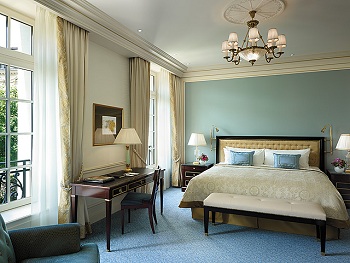
Interestingly, the hotel’s most expensive suite, the nearly 3000-sq.-ft. Imperial Suite, whose posted rate is 18000€ per night, does not have an Eiffel Tower view. That’s because that suite is a part of Roland Bonaparte’s original private mansion, and Eiffel’s Tower, completed several years before the mansion was built, held little favor with the upper class at the turn of the century.
Bar and Restaurants
The Shangri-La Hotel has three restaurants: the intimate and formal L’Abeille (The Bee), named for a symbol of the Bonaparte family, the polished La Bauhinia, named for the flower on the flag of Hong Kong, serving French cuisine along with select Asian dishes, and Shang Palace, serving gourmet Cantonese cuisine. A “well-being space,” including a swimming pool, is due to open later this year for the exclusive use of hotel guests.
*
For more on Shangri-La’s public areas, in particular its bar and the restaurant La Bauhinia, read the continuation of this review: La Bauhinia at Shangri-La: Seductively Polished Cuisine and a Little Cleavage.
For the prequel to this article see: In Transit: The Route to Shangri-La Is Paved with Good Intentions.
*
Shangri-La Hotel, 10 avenue d’Iéna, 16th arrondissement. Tel. 01 53 67 19 91. Room rates begin at 750€ (over $1000) per night.
Comments may be left below.

